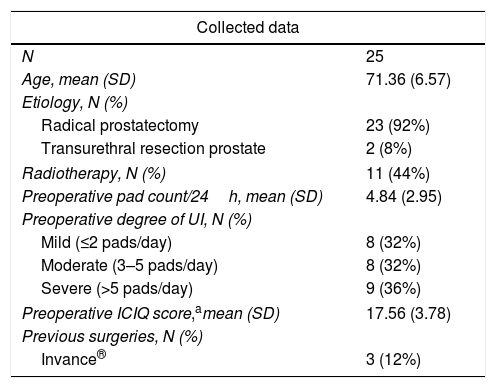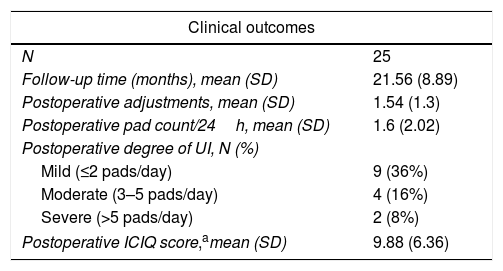Urinary incontinence (UI) is a complication of radical prostatectomy (RP) and transurethral resection of the prostate (TURP). The gold-standard treatment is the artificial urinary sphincter, however, new treatments have been investigated.
ObjectiveTo examine the outcome of an adjustable transobturator male system (ATOMS®) in men with UI after prostatic surgery in a low to medium volume continence center.
Materials and methodsTwenty-five men with UI were implanted with ATOMS® system between 2012 and 2014. The most common indication was UI after RP (92%), followed by UI after TURP (8%). Eleven patients (44%) had received adjuvant external beam radiotherapy (RT). Patients were considered to be ‘dry’ if they stopped wearing pads or needed just one protective pad per day; and improved if the daily number of pads used decreased by at least half. The Incontinence Quality of Life questionnaire (ICIQ-SF) was used, adding a verbal question about the satisfaction of the patient considering the outcome.
ResultsAfter a mean follow-up of 21.56 months, 64% were dry and 8% revealed a significant improvement. The success of the procedure was negatively correlated with the severity of the previous UI and with previous treatment with RT. Concerning patients satisfaction, 84% of the patients would repeat the procedure.
ConclusionATOMS® offers good rates of cure and improvement of UI after prostatic surgery with a reasonable rate of minor complications. The results of this study, performed in a low to medium volume continence center, are comparable to the results achieved in high volume continence centers.
La incontinencia urinaria (IU) es una complicación de la prostatectomía radical (PR) y de la resección transuretral de próstata (RTUP). El tratamiento de referencia es el esfínter urinario artificial; sin embargo, han surgido nuevos tratamientos.
ObjetivoExaminar el resultado de un sistema masculino transobturador ajustable (ATOMS®) en varones con IU tras cirugía prostática en un centro de continencia de volumen bajo a medio.
Materiales y métodosVeinticinco hombres con IU han sido implantados con el sistema ATOMS® entre 2012 y 2014. La indicación más común ha sido la IU después de PR (92%), seguida de IU por RTUP (8%). Once pacientes (44%) habían recibido radioterapia adyuvante (RT). Se han considerado «secos» los que dejaron de usar compresas o necesitaron solo una compresa protectora; y mejorados aquellos en que el número de compresas usadas disminuyó por la mitad. Se ha utilizado el cuestionario de calidad de vida de la incontinencia (ICIQ-SF), agregando una pregunta sobre la satisfacción del paciente.
ResultadosDespués de un seguimiento medio de 21,56 meses, el 64% estaban secos y el 8% revelaron una mejoría significativa. El éxito del procedimiento se correlacionó negativamente con la severidad de la IU previa y con el tratamiento con RT. Al final, el 84% repetirían el procedimiento.
ConclusiónATOMS® ofrece una elevada tasa de éxito con una tasa razonable de complicaciones menores. Los resultados de este estudio, realizado en un centro de continencia de volumen bajo a medio, son comparables a los resultados obtenidos en centros de continencia de alto volumen.
Artículo
Comprando el artículo el PDF del mismo podrá ser descargado
Precio 19,34 €
Comprar ahora









